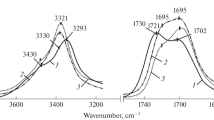Abstract
The influence exerted by the molecular mass of the oligoether and structure of the diisocyanate (starting compounds in the synthesis of epoxy–urethane oligomers) on the thermal behavior and physicomechanical properties of elastomers synthesized from them was studied. The use of isophorone diisocyanate allowed synthesis of materials with a higher degree of microphase segregation compared to 2,4-toluene diisocyanate, which led to the preparation of materials with a lower glass transition point.






Similar content being viewed by others
REFERENCES
Ling, Z., Hyun, K.J., Jeff, M., Ron, H., and Christopher, W.M., Polymer, 2007, vol. 48, no. 22, pp. 6656–6667.
Mekewi, M.A., Ramadan, A.M., ElDarse, F.M., Abdel Rehim, M.H., Mosa, N.A., and Ibrahim, M.A., Egypt. J. Petrol., 2017, vol. 26, no. 1, pp. 9–15. https://doi.org/10.1016/j.ejpe.2016.02.002
Randall, D. and Lee, S., The Polyurethanes Book, New York: Wiley, 2003.
Prisakariu, C., Polyurethane Elastomers. From Morphology to Mechanical Aspects, Vienna: Springer, 2011.
Sun, W., Yan, X., and Zhu, X., Polym. Bull., 2012, vol. 69, no. 5, pp. 621–633. https://doi.org/10.1007/s00289-012-0775-1
Edwards, P.A., Striemer, G., and Webster, D.C., JCT Res., 2005, vol. 2, no. 7, pp. 517–527. https://doi.org/10.1007/s11998-005-0011-0
Yeganeh, H., Mehdipour-Ataei, S., and Ghaffari, M., High Performance Polym., 2008, vol. 20, no. 2, pp. 126–145. https://doi.org/10.1177/0954008307082743
Bera, M., Gupta, P., and Maji, P.K., React. Funct. Polym., 2019, vol. 139, pp. 60–74. https://doi.org/10.1016/j.reactfunctpolym.2019.03.008
Elchueva, A.D., Nazipov, M.M., Tabachkov, A.A., and Liakumovich, A.G., Russ. J. Appl. Chem., 2003, vol. 76, no. 3, pp. 487–490. https://doi.org/10.1023/A:1025681524423
Makarova, M.A., Slobodinyuk, A.I., Tereshatov, V.V., Volkova, E.R., and Kisel’kov, D.M., Polym. Sci., Ser. D, 2014, vol. 7, no. 3, pp. 166–169. https://doi.org/10.1134/S1995421214030137
Strel’nikov, V.N., Senichev, V.Y., Slobodinyuk, A.I., Savchuk, A.V., and Volkova, E.R., Int. J. Polym. Sci., 2019, vol. 2019, article ID 5670439. https://doi.org/10.1155/2019/5670439
Guadagno, L., Vertuccio, L., Sorrentino, A., Raimondo, M., Naddeo, C., Vittoria, V., Iannuzzo, G., Calvi, E., and Russo, S., Carbon, 2009, vol. 47, no. 10, pp. 2419−2430. https://doi.org/10.1016/j.carbon.2009.04.035
Zhang, S., Ren, Z., He, S., Zhu, Y., and Zhu, C., Spectrochim. Acta, Part A: Mol. Biomol. Spectrosc., 2007, vol. 66, no. 1, pp. 188–193. https://doi.org/10.1016/j.saa.2006.02.041
Ahn, T.O., Jung, S.U., Jeong, H.M., and Lee, S.W., Appl. Polym. Sci., 1994, vol. 51, no. 1, pp. 43–49. https://doi.org/10.1002/app.1994.070510105
Senichev, V.Y., Slobodinyuk, A.I., Makarova, M.A., Savchuk, A.V., and Pogoreltsev, E.V., J. Phys.: Conf. Ser., 2019, vol. 1399, no. 4, p. 044060. https://doi.org/10.1088/1742-6596/1399/4/044060
Kothandaraman, H. and Nasar, A.S., Polymer, 1993, vol. 34, no. 3, pp. 610–615. https://doi.org/10.1016/0032-3861(93)90558-R
ACKNOWLEDGMENTS
The study was performed using the equipment of the Center for Shared Use “Studies of Materials and Substance,” Perm Federal Research Center, Ural Branch, Russian Academy of Sciences.
Funding
The study was financially supported by the Russian Foundation for Basic Research and by the Perm krai Government (project no. 19-43-590005).
Author information
Authors and Affiliations
Corresponding author
Ethics declarations
The authors declare that they have no conflict of interest.
Rights and permissions
About this article
Cite this article
Senichev, V.Y., Slobodinyuk, A.I., Slobodinyuk, D.G. et al. Frost-Resistant Elastomers with Controllable Microphase Segregation, Based on Epoxy–Ether–Urethane Oligomers. Russ J Appl Chem 93, 1172–1178 (2020). https://doi.org/10.1134/S1070427220080091
Received:
Revised:
Accepted:
Published:
Issue Date:
DOI: https://doi.org/10.1134/S1070427220080091




